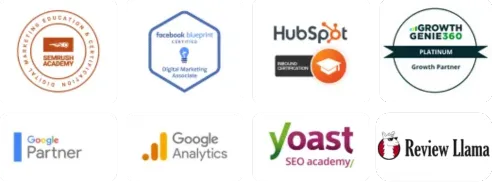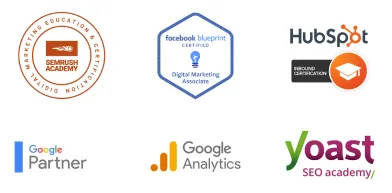TO LEARN IS TO GROW
Learning Center
We do our research and publish our results. Should probably call this the Growing Center.


Top 6 Reasons Why Your Website Traffic Sucks
These are the top 6 reasons why your website traffic sucks and the corresponding tips to fix them.
If you want your business to grow and survive in today’s business landscape and new customer behavior, you have to ensure that your website is getting a healthy amount of traffic. But first things first, what makes traffic poor?
Digital marketing and online branding expert LOJO Marketing interviewed several industry leaders who provided varying definitions of a poorly performing website.
For local businesses, having less than 500 visits per month is considered low. However, this is not a hard-and-fast rule because some industries such as hotels, restaurants, local stores, and car dealerships enjoy high website traffic historically speaking, whereas marketing companies are among the least visited sites.
If the website has less than 5-10 conversions per week, it could mean low traffic.
Instead of the actual number of website visitors, it might be better to look at the conversion rates, such as how many visitors purchase your product or sign up for your newsletter or ebook.
Aside from conversion rates, businesses should also consider how long the visitors stay on the website. If the bounce rate is high--i.e., most visitors leave after a few seconds or even without scrolling down--it is a sign of a poorly performing site.
For paid ads, a poorly performing website means that the [meager] sales do not justify the cost of the pay-per-click or PPC ads.
Top 6 Reasons Why Your Website Traffic Sucks
The list below explains the top 6 reasons why a website has low traffic or poor performance compared to the industry average. We also include some tips on how to correct or at least improve these problems.
There is no concrete search engine optimization strategy.
SEO is the process of improving the quantity and quality of web traffic, allowing users to find your site when they type the keywords into the search engine box like Google and Bing.
This multi-layer method includes optimizing your on-page SEO (your actual website), off-page (anything that happens outside your site), local SEO, and technical SEO.
These are the most fundamental SEO best practices:
Publish high-quality, customer-centric content.
Optimize your website's loading speed; aim for a half-second speed.
Mention your keywords early on in your content (title and headings).
Optimize your images, meaning you need to change the "weird" characters into readable, descriptive text.
Use internal links to improve your SEO and user experience.
Use Google Search Console to track your SEO results.
Write relevant, easy-to-understand titles and descriptions.
Build high-quality backlinks.
The backlink profile is weak.
A backlink, which is a link from one website to another, can play a significant role in your search rankings. Take note that Google “assumes” that if a site has high-quality links, it must be a reputable industry leader.
Authority websites like government agencies, well-known NGOs and groups, and household brands (e.g., Coke, Starbucks, Amazon, Walmart, etc.) have excellent backlink profiles because they are already popular offline. By contrast, local and small businesses and companies with niche markets typically struggle to gain high-quality links.
However, blog commenting is one way to fix a weak backlink profile. While it’s true that most blogs nowadays have no-follow links on the comment box, it remains a worthwhile strategy provided that you do the following tips:
Read a blog post that is relevant to your industry, business, or target audience.
Go to the comment section and leave a relevant comment.
Do this strategy frequently to create a backlink profile that combines no-follow and do-follow links.
Pro Tip: Guest blogging remains the best source of high-quality backlink and referral traffic.

Presence of technical issues.
Technical issues such as snail-paced loading time, broken links, lack of sitemap, and 404 errors are technical issues that have detrimental effects on your SEO and website traffic. But fortunately, these are relatively easy to fix with the use of Google Webmaster Tools, Google Analytics, Alexa, Google Mobile-Friendly Test, Moz, and other similar tools.
To ensure that your website is not having technical issues, use A/B testing, aka split testing, in which you compare two versions of a web page to identify which performs better.
The website runs on a low-quality web hosting provider.
Using a low-quality web hosting provider can result in slow page loading times and server overload, leading to poor traffic and performance.
If your website traffic is doing well historically but then experiences a sudden drop, server overload is the usual culprit which happens when the web host provider cannot keep up with the increasing number of visitors.
You can easily change your web host if you are not happy with the loading speed or the quality of the content network distribution.
Lack of keyword strategy.
If you are a small business just starting with your SEO campaign, a good rule of thumb is to target only around five keywords. However, it does not mean that your site will only get traffic from these limited keywords.
Once your SEO campaign becomes more established, you can add more keywords to make your products and services more searchable by people and search engine robots (e.g., Google and Bing).
Another thing to keep in mind: For small- and medium-sized businesses, using long-tail keywords–i.e., phrases that usually consist of 3-5 words–makes more sense than short-tail keywords because of the following reasons:
It is easier to achieve good search rankings since short-tail keywords are already dominated by authority websites like government agencies, household products, and well-known organizations.
Long-tail keywords tend to attract high-quality traffic to your website, which means better conversion rates.
Initially, these niche keywords might seem counterintuitive because they filter out some traffic, but long term, they can serve as a valuable tool that can boost your sales and brand awareness.
However, it still makes sense to use short-tail keywords every once in a while. The goal is to drive high-quality traffic to your website and at the same time grow your authority by creating superb content, doing frequent guest blogging and interviews, and backlinking.

The content is crappy or outdated.
Gone are the days when keyword stuffing was rewarded with a high search ranking. With Google bots becoming smarter and more user-centric, the only way to get on top of the search engine results page (SERP) is to provide valuable, high-quality content that will engage your audience.
This is a list of guidelines to fix crappy content:
Understand your target audience.
Avoid frills and meaningless jargon.
Stick to the "one paragraph, one idea" rule.
Include quantifiable facts and reputable sources.
Emphasize action, i.e., rely more on verbs than adverbs and adjectives.
Write compelling headlines.
Keep your content simple and concise.
Write with SEO in mind.
Ensure that your content has a definite purpose.
Try to be "conversational"--use "you" and "your."
Pro Tip: Complement your high-quality written content with professional-looking images, videos, infographics, and other design elements.
Conclusion About Why Your Website Traffic Sucks
Poor website traffic may also stem from outdated content. As a result, you must maintain a blog, which is a platform that can drive search traffic to your site, boost your rankings, and help improve your brand awareness and loyal customer base.
To learn more about improving your website traffic and conversion rates, particularly your sales and followers, contact LOJO Marketing at (916) 303-4080.
Built for Growth. Backed by 25 Years of Trust.
For over two decades, LOJO has been a trusted partner to hundreds of businesses just like yours. Whether working directly with owners, managers, teams, or boards of directors, our goal remains the same: to be a reliable and results-driven asset to your business.
Over the years, we’ve carefully built a team of experts—each selected for their unique skills, strengths, and personalities. Our clients choose LOJO because they know we genuinely care about their success.
And after 25 years of helping businesses grow, we’re more committed than ever.


Built for Growth. Backed by 25 Years of Trust.
For over two decades, LOJO has been a trusted partner to hundreds of businesses just like yours. Whether working directly with owners, managers, teams, or boards of directors, our goal remains the same: to be a reliable and results-driven asset to your business.
Over the years, we’ve carefully built a team of experts—each selected for their unique skills, strengths, and personalities. Our clients choose LOJO because they know we genuinely care about their success.
And after 25 years of helping businesses grow, we’re more committed than ever.




Matthew Rogers, President
iProspect Check
After spending several months reviewing multiple proposals from several different companies we engaged LOJO to develop a new website that represents our company effectively. We worked initially with Stephen Platte who helped create the scope of the project. Stephen was knowledgeable and always followed up with me on time and as promised.
He "closed the deal" for LOJO with his professionalism, service orientation and easy going approach. Once we signed the contract we were introduced to Jay Kelly who would be the creative lead for LOJO. This was the most challenging part of the project for my company, as there was no shortage of ideas from our side. Jay managed the project flawlessly, and once we had all agreed to the design, Jay introduced us to Eric.
Eric Lay is one of the founders of LOJO. Eric took the design we had developed and brought it to life. We delivered content as quickly as he requested it. Eric kept the project on task and we responded by exceeding every deadline for content. In turn, once provided, literally not a day went by that Eric didn't add the content and take the next step. In just a few weeks we launched our new website. Eric is a pleasure to work with.
His positive attitude and consultative approach really enhanced the experience and made a big difference for us in the outcome of our project. We would welcome you to visit our website to take a look at the quality work of LOJO. We are very pleased with LOJO and look forward to working with them in the future as we pursue an aggressive SEO strategy."
After spending several months reviewing multiple proposals from several different companies we engaged LOJO to develop a new website that represents our company effectively. We worked initially with Stephen Platte who helped create the scope of the project. Stephen was knowledgeable and always followed up with me on time and as promised.
He "closed the deal" for LOJO with his professionalism, service orientation and easy going approach. Once we signed the contract we were introduced to Jay Kelly who would be the creative lead for LOJO. This was the most challenging part of the project for my company, as there was no shortage of ideas from our side. Jay managed the project flawlessly, and once we had all agreed to the design, Jay introduced us to Eric.
Eric Lay is one of the founders of LOJO. Eric took the design we had developed and brought it to life. We delivered content as quickly as he requested it. Eric kept the project on task and we responded by exceeding every deadline for content. In turn, once provided, literally not a day went by that Eric didn't add the content and take the next step. In just a few weeks we launched our new website. Eric is a pleasure to work with.
His positive attitude and consultative approach really enhanced the experience and made a big difference for us in the outcome of our project. We would welcome you to visit our website to take a look at the quality work of LOJO. We are very pleased with LOJO and look forward to working with them in the future as we pursue an aggressive SEO strategy."

Matthew Rogers, President
iProspect Check
The team at LOJO were wonderful to work with. They are well organized and very patient as we worked through our marketing strategy and developed a well thought out and clear action plan at a reasonable price. We will definitely be back for our future campaign needs."

Jon Crosby, Founder
Dazil

